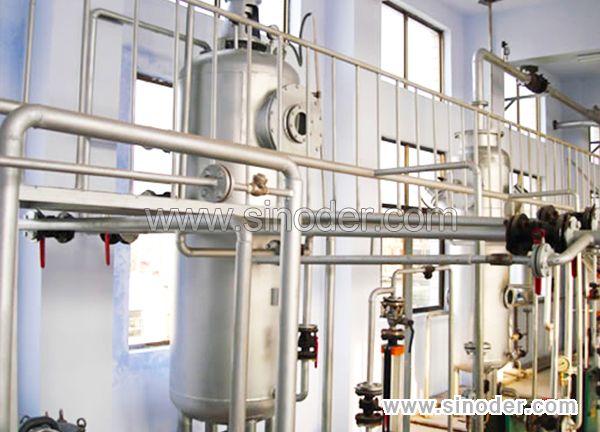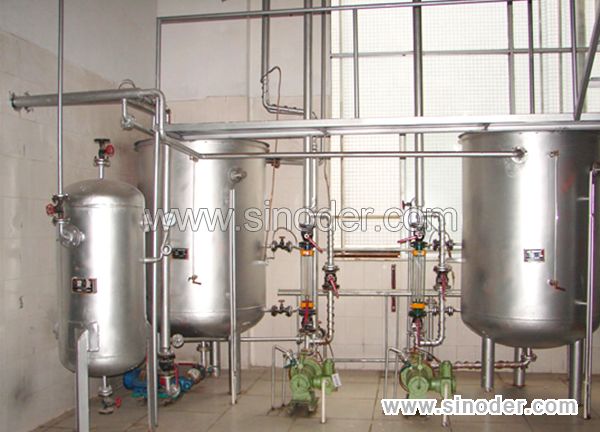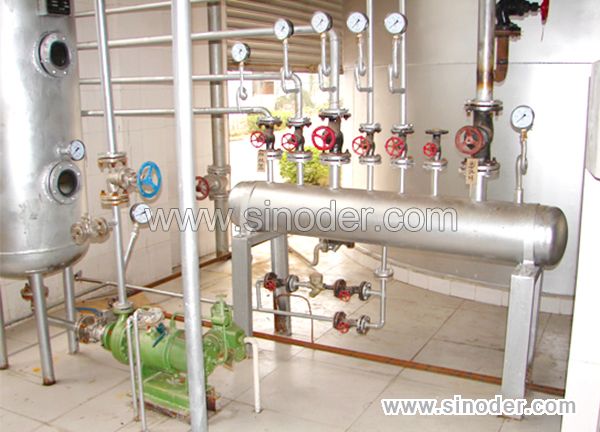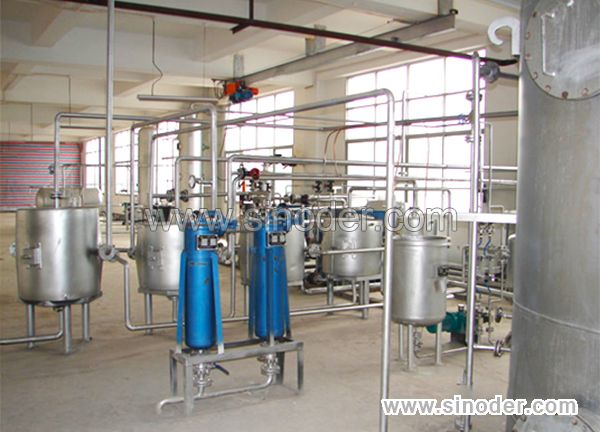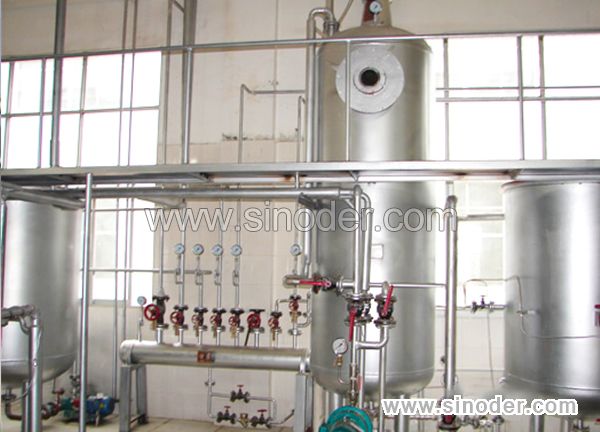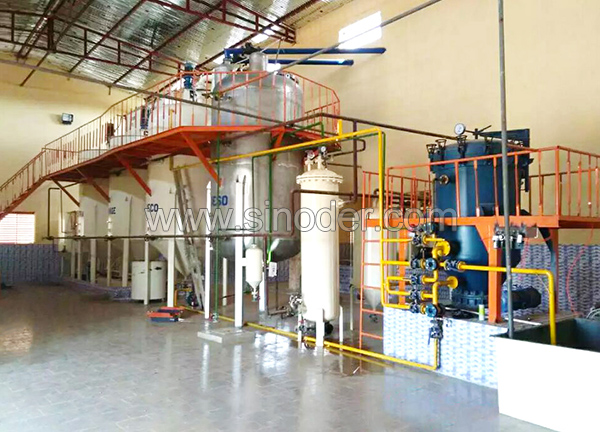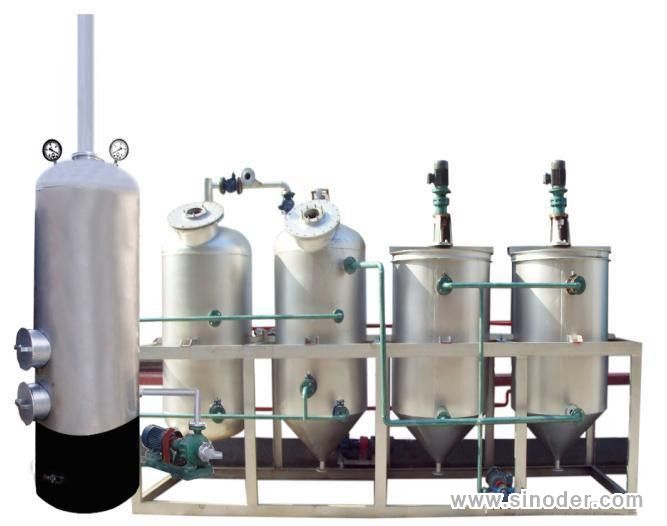Continuous Type Oil Refinery Plant
Continuous Type Oil Refinery Plant is recommended against the batch refining for higher capacity plants above 30 tons per day and for oils containing higher FFA content. This process line is bit expensive than batch process but it provides superior quality refined oil along with automation system and low processing cost.
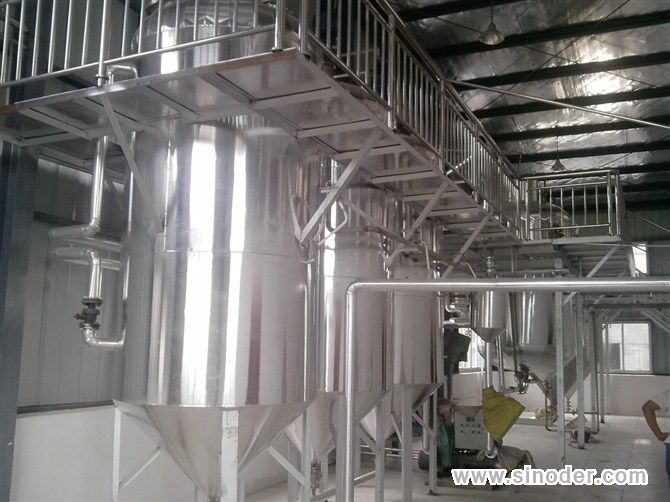 Process Description for Continuous Oil Refinery Plant:
Process Description for Continuous Oil Refinery Plant:
Continuous refinery line comprises of the following different processes:-
Degumming or Pretreatment Section
Neutralizing Section
Bleaching Section
Deodorizing Section
Dewaxing section
Two processes have been developed for continuous refining of edible oils i.e. chemical refining and physical refining.
 Vegetable Oil Refinery Plant- Physical Refining:
Vegetable Oil Refinery Plant- Physical Refining:
Our physical method of refining removes the Free Fatty Acids in single stage of deodorization process while the gum content from the crude oil is removed in the degumming process. In physical refining, comparatively more FFA is distilled out giving a high oil refining rate with minimum oil loss. For oils like palm oil there is no necessity to go for alkali refining. After pretreatment of oil the oil is deodorized cum physically refined.
Vegetable Oil Refinery Plant- Chemical Refining:
Chemical refining is most widely used method for refining all types of crude oils. Chemical method of refining removes the Free Fatty Acids and other impurities in a chemical way by Acid-Base neutralization process. Caustic soda is used as a base for this method. The addition of Caustic Soda to the acid completes the neutralization. This results in the formation of sodium soaps and gums which are then separated by Separators & Centrifuges. The neutralized oil is subsequently bleached and deodorized. We offer highly productive chemical refining technology with effective refining techniques. Our oil refinery plants are working successfully all around the world.
Dry Fractionation
The widespread use of the three oil modification processes - hydrogenation, interesterification and fractionation - extended the range of applications of the triglyceride oils. These processes principally serve the purpose of modifying the melting properties of oils and fats in order to improve their functional properties in specific applications, but the processes are also used to improve the stability of the oils and fats thus processed.
In edible oil processing, a fractionation process consists of a controlled cooling of the oil, thereby inducing a partial, or ‘fractional’, crystallization. The remaining liquid (olein) is then separated from the solid fraction (stearin) by means of filtration or centrifugation.
Natural oils and fats have different characteristics due to the fact that they are composed of a great number of different triglycerides. These contain fatty acids with carbon chins of different lengths and with different degrees of unsaturation.
Triglycerides with a high degree of unsaturation, indicated by a high iodine value, have a lower melting point than those containing more saturated fatty acids. If oil is cooled to a certain temperature, the high melting triglyceride (Stearin) will crystallize while the low melting ones will remain fluid. The stearin can then be separated from oil (Olein) by different methods and the fat/oil is thus divided into two fractions: Stearin with a high melting point and olein with a low cloud and melting points.
This technique is called fractional crystallization and used to obtain oils or fats more suitable for example, as cooking oils or for margarine/shortening production.
Three palm oil fractionation processes which are in use:
Dry Fractionation: through batch crystallization of oil without using additives by controlled cooling and subsequent continuous filtration.
Solvent Fractionation: through continuous crystallization of the oil in a solvent followed by separation of the liquid and solid fractions through a continuous drum filter. Solvent fractionation, involves the use of hexane or acetone to let the high-melting components crystallize in a very low-viscous organic solvent. This can be helpful with respect to the selectivity of the reaction, but mainly offers advantages in the field of phase separation: much purer solid fractions can be obtained, even with a vacuum filtration. Being a more expensive process, it is less common than dry fractionation and only comes into the picture when a very high added value of (at least one of) the resulting fractions makes up for the high cost.
Detergent Fractionation: through batch or continuous crystallization of the oil by controlled cooling and separation of the fractions either by gravity or centrifugation after adding a surfactant.
MIXED REFINING
What is Refining?
The crude oil obtained either from expellers or solvent extraction plant contains impurities, which must be removed to make the oil edible, more palatable and stable against rancidity upon storage. The process of removing these impurities is called refining.
Impurities present in the Oil
Gums: Gums are phospholipids. There are two types of gums present, hydratable and non-hydratable. Hydratable gums are removed during degumming steps.
Hydrolysis Products Of Oils: Like Diglycerides and monoglycerides and free fatty acids. These are removed during neutralisation step.
Proteineous Matter, Carbohydrates, Resins: These are removed during neutralisation step.
Colouring Matter: Pigments such as chlorophyll (green colour) carotene (red colour), anthophyll (yellow colour) and gossypol (orange colour). These colour bodies which impart distinct colour to the oil are removed during neutralising and bleaching steps.
Odour-causing Chemicals: They are generally present in small quantities but their presence imparts strong, sometimes objectionable odour to the oil. These substances are volatile in nature and removed by deodorisation step.
Waxes: Some oils like sunflower contains appreciable amounts of waxes. Waxes are high melting esters of fatty alcohol with long chain fatty acids. These are removed by dewaxing step.
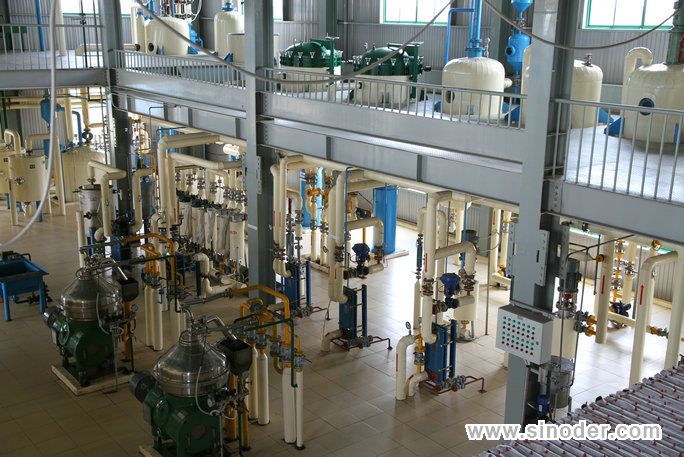 What is Mixed Refining ?
What is Mixed Refining ?
Mixing is defined as a mixture of oil and solvent that results from the extraction of flakes or extruded cottonseed kernels. Thus the refining of the oil in a solvent (usually Hexane) in which it was extracted is known as “Mixed Refining ”. Refining is done to remove pigments, free fatty acids and other mucilaginous materials.
The crude Mixing feedstock from the extractor is first adjusted to the desired Mixing concentration by evaporation in the first stage evaporator or economiser against the outgoing vapours from the deodorosed tank.
The crude Mixing is pumped through a heat exchanger to bring the Mixing upto the desired processing temperature.
The crude Mixing proceeds through a flow measuring device enters the neutralization process.
This process is completed by a four step process: Conditioning, Neutralization, Washing, and Drying.
The fats are heated between 40º and 85ºC and treated with an aqueous solution of sodium hydroxide(Caustic Soda).
Conditioning transforms non-hydrate phospholipids into their hydrate form by breaking down metal/phosphatide complexes with a strong acid(Phosphoric Acid).
In neutralization the removal of free fatty acids and residual gums takes place.
Washing is the removal of residual gums by hot water.
Drying is the removal of moisture under a vacuum.
The reacted mixture is then passed through a trim heat exchanger to ensure the proper temperature for the centrifugation in the Hermetic Self cleaning centrifuge. The light coloured, refined Mixing is easily separted from the dark brown gelatinuous soapstock in the specially designed centrifuge with nitrogen blanketing. The oil is dissolved in hexane in Mixed Refining , which is why the separators which separate the soapstock from the neutralization process are blanketed with inert gas.
The refined Mixing then reenters the extraction plant stripping system for removal of remaining hexane.
The soapstock, with its low hexane content, is usually pumped directly to the desolventiser-toaster for the recovery of hexane.
The addition of soapstock to the meal in the deodorized tank helps prevent excessively dusty meal and gives it a more natural appearance and makes it easier to handle. The soapstock generally increases the weight and fat content of the meal by approximately 0.9% and adds to its nutrient and commercial value as an animal feed.
The soapstock also tends to decrease the free gossypol content remaining in the solvent extracted meal.
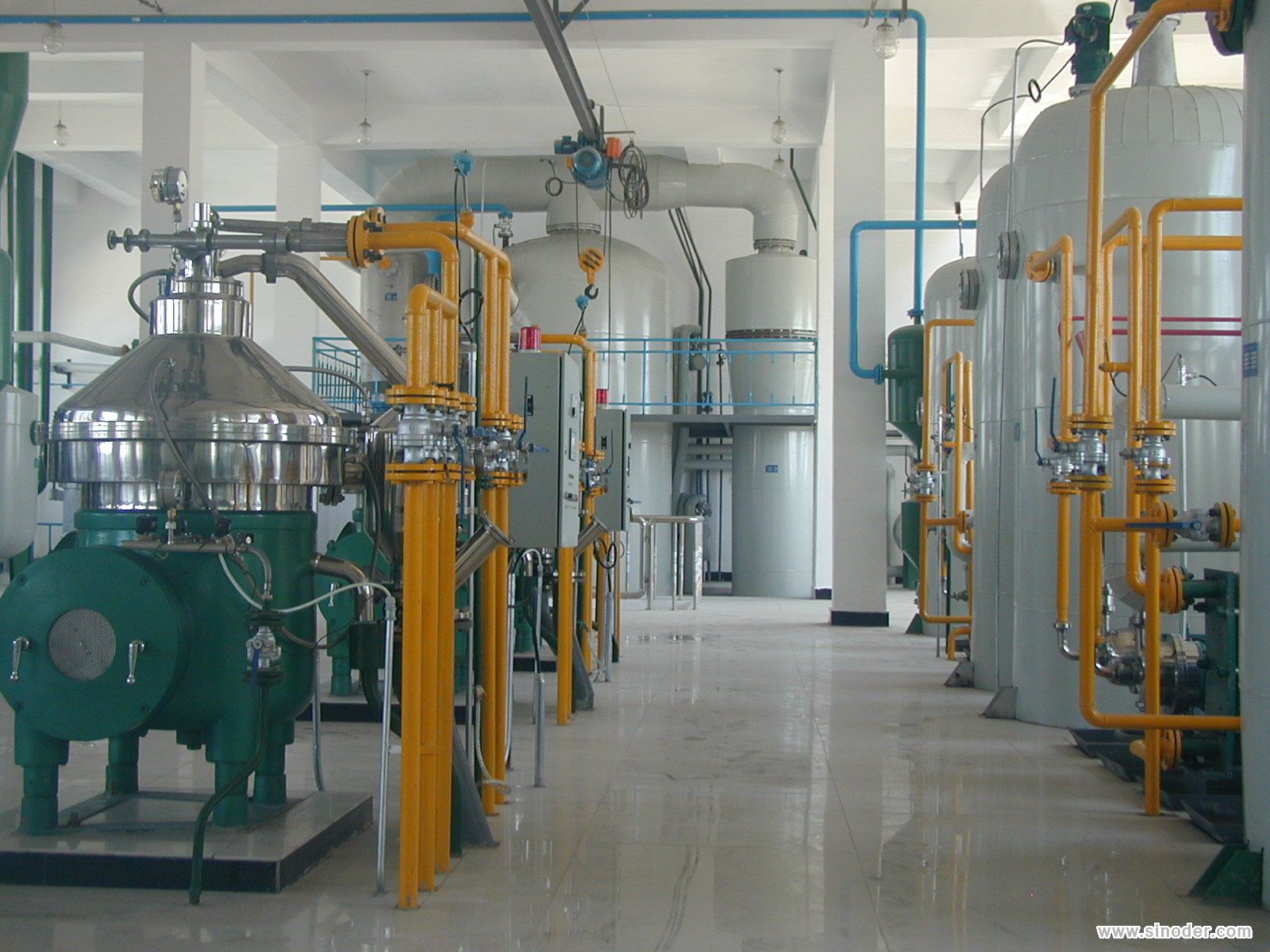 FAQ:
FAQ:
Our
Sinoder Indutech Machinery Company supply the complete set of Cooking oil production line machinery including sunflower oil production line, palm oil production line, soya bean oil production line, peanut oil production line, cotton seeds oil production line, maize corn germ oil production line, clamelia oil production line, rapeseeds oil production line, canola oil production line, coconut cropra oil production line, shea oil production line, groundnuts oil line, sesame oil production line,black seeds oil production line, jatropha seeds oil production line,moringa seeds oil production line and other vegetables oil processing machines.
Q1 : Which kind of materials can be processed?
All kinds of oil seeds. For example, sunflower seeds, rice bran, corn germ, palm fruit, palm kernel,coconut,peanut, soybean, sesame, cottonseeds, rapeseed, etc.
Q2 : What's the capacity?
Generally, 10-5000 tons per day. We can also manufacture as per customers' requirements.
Q3 : How long is the warranty?
The main parts of the machine come with one year warranty and after the expiration our engineer is available overseas to do the maintenance work.
Q4 : Can the machine be installed locally?
We can do the turn-key projects or other services according to customers'requirements,according to this condition,our services can be manufacturing,purchasing,transporting,installation,training labors etc.
Q5 : How to operate the machine?
Our engineers will be available to guide and train your labors how to operate and run the machine.
If you want to know more the vegetable oil processing machines and cooking oil refinery plants, pls feel free to visit our special webstie: http://www.oilgrainmachine.com and send us the detail requirements by email.
E-mail: rockwell@sinoder.com
Mobile Phone/Whatsapp: 0086-18037503060 (Mr.Rockwell Ni)


